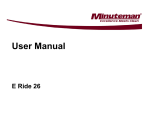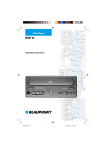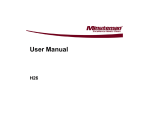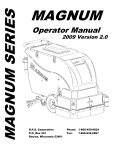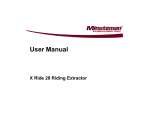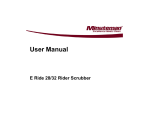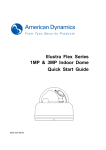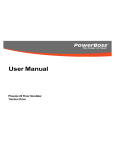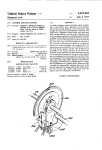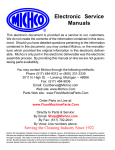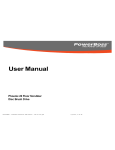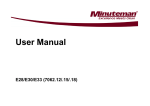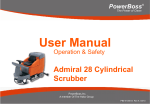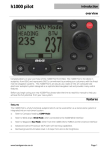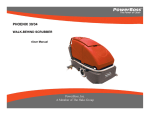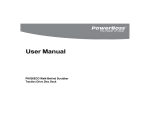Download 988726umpb - User Manual - Admiral 26 REV A 1011.book
Transcript
User Manual Admiral 26 Introduction Preface Dear customer, Thank you for purchasing the PowerBoss® Admiral 26. The outstanding operational characteristics of the Admiral 26 should justify the confidence you demonstrated in making this purchase. The Admiral 26 is a commercial grade scrubber machine. It is battery operated and is intended by PowerBoss to be used in accordance with this manual, the labels on the machine itself, as well as applicable federal, state, and local safety and environmental statutes, regulations, and ordinances (collectively the "governmental regulations"), applicable commercial standards, and common sense. . The user's own safety, as well as the safety of others, depends to a great extent on how the Admiral 26 is operated, handled, and maintained. Therefore, as a starting point, this manual must be read and understood thoroughly prior to the machine being switched on for the first time. When operating or maintaining the Admiral 26, THINK SAFETY FIRST! This manual provides vital information concerning the safe operation, use, 2 maintenance, and service of the Admiral 26. The various safety alert symbols, signal words, and safety messages contained herein are intended to be read in conjunction with each other, as well as with Admiral 26 labels, instruction plates, and applicable governmental regulations. To the extent that any governmental regulations conflict with the provisions of this instruction manual, such governmental regulations would govern. Your authorized PowerBoss dealer would be happy to answer any questions you may have concerning the operation or maintenance of the Admiral 26 or information contained in this manual. If repair or maintenance work is performed on the Admiral 26, PowerBoss recommends that only genuine replacement parts be used and that such work be performed by qualified individuals. Proper use The Admiral 26 is a vacuum scrubbing machine. Its intended scope of application is for wet cleaning of level, smooth, hard-surfaced floors in accordance with the provisions of this instruction manual, applicable governmental regulations, manufacturer specifications, and machine labels (collectively, "proper use"). Using the Admiral 26 beyond its proper use will be deemed improper use by PowerBoss. PowerBoss disclaims any liability for any personal injury, property, or other damages of any nature whatsoever, whether special, indirect, consequential, or compensatory, directly or indirectly resulting from the improper use of the Admiral 26, or uses beyond or inconsistent with the Admiral’s intended scope of application. This disclaimer of liability also extends to modifications to the Admiral 26 made without PowerBoss' prior written consent. The Admiral 26 should only be operated, handled, and maintained by persons who are familiar with the machine and who have been instructed of the potential hazards associated with such operation, handling, and maintenance. Introduction Disclaimer: PowerBoss disclaims liability for any personal injury, property, or other damages of any nature whatsoever, whether special, indirect, consequential, or compensatory, directly or indirectly resulting from the publication, use of, application, or reliance on this document or, except as expressly set forth in the sales contract for the machine, the operation or maintenance of the Admiral 26. EXCEPT AS EXPRESSLY SET FORTH IN SUCH SALES CONTRACT, POWERBOSS MAKES NO WARRANTIES, EXPRESS OR IMPLIED, AND SPECIFICALLY DISCLAIMS ANY WARRANTY OF MERCHANTABILITY OR FITNESS FOR A PARTICULAR PURPOSE. PowerBoss disclaims and makes no guaranty or warranty, express or implied, as to the accuracy or completeness of any information published herein, and disclaims and makes no warranty that the information in this instruction manual will fulfill any parties' particular purposes or needs. While PowerBoss believes that the information in this manual is accurate, in the event that technical or typographical errors exist in this manual, PowerBoss reserves the right to make changes to subsequent editions of this manual without prior notice to the recipients of this edition. The reader should notify PowerBoss if any errors in this manual are suspected. PowerBoss does not undertake to guarantee the performance of any individual manufacturer or seller's products or services by virtue of this instruction manual. In publishing and making this manual available, PowerBoss is not undertaking to render professional or other services for or on behalf of any person or entity, nor is PowerBoss undertaking to perform any duty owed by any person or entity to someone else. Anyone using this manual should rely on his or her own independent judgment or, as appropriate, seek the advise of a competent professional in determining the exercise of reasonable care in any given circumstances. Valid as of: October 2011 PowerBoss Inc. 175 Anderson Street Aberdeen, North Carolina 28315 U.S.A. 3 Introduction Notes on warranty The terms of the sales contract apply in regard to any product warranties. PowerBoss expressly disclaims all other warranties, either express or implied, of any kind. It should be noted, however, that failure to maintain and service your Admiral 26 in accordance with its proper use may void the warranty. In this regard, any maintenance work must be performed by an authorized PowerBoss service representative and confirmed in the "Maintenance Certificate" - the warranty document. By way of example, the following items are excluded from the Admiral 26 warranty: fuses; normal wear and tear; improper machine handling; damages caused by overloads; unauthorized machine modifications; non-compliance with maintenance instructions or specifications; or improperly fitting parts or accessories. 4 Acceptance of the machine Upon arrival, check machine for possible damages in transit. Follow unpacking instructions on shipping pallet. Each unit has been tested and throughly inspected before shipment. Any damage is the responsibility of the delivery carrier who should be notified immediately. PowerBoss Inc. 175 Anderson Street Aberdeen, North Carolina 28315 U.S.A. Table of Contents 1.7 2 2.1 2.2 3 3.1 3.2 Introduction . . . . . . . . . . . . . 2 Preface. . . . . . . . . . . . . . . . . . 2 Proper use . . . . . . . . . . . . . . . 2 Disclaimer . . . . . . . . . . . . . . . 3 Notes on warranty . . . . . . . . . 4 Acceptance of the machine . . 4 Safety Information . . . . . . . . 8 Safety and Warning Symbols. 8 General Provisions. . . . . . . . . 9 Operational Precautions. . . . 10 Maintenance Precautions. . . 11 Battery and Electrical System Precautions . . . . . . . . . . . . . 12 Cleaning Solution Use and Disposal Precautions. . . . . . . . . 13 Machine Labels . . . . . . . . . . 14 Machine Overview . . . . . . . 16 Front. . . . . . . . . . . . . . . . . . . 16 Rear . . . . . . . . . . . . . . . . . . . 17 Operating Elements . . . . . . 18 Operating Panel . . . . . . . . . . 18 At the Machine . . . . . . . . . . . 21 4 4.1 4.2 4.3 4.4 First Operation . . . . . . . . . . 26 Instruction. . . . . . . . . . . . . . . 26 Initial charging procedure. . . 26 Before Putting into Operation 26 Start Machine . . . . . . . . . . . . 26 1 1.1 1.2 1.3 1.4 1.5 1.6 4.5 4.6 4.7 4.8 4.9 5 5.1 5.1.1 5.1.2 5.1.3 5.1.4 5.1.5 5.1.6 5.1.7 6 7 7.1 7.2 7.3 7.4 7.4.1 7.4.2 7.4.3 7.4.4 7.4.5 7.4.6 7.5 Operation . . . . . . . . . . . . . . . Stop Machine . . . . . . . . . . . . After Work . . . . . . . . . . . . . . Transporting the machine . . Tie-down points . . . . . . . . . . Operation . . . . . . . . . . . . . . Method of Operation . . . . . . Brush Deck . . . . . . . . . . . . . Solution Tank . . . . . . . . . . . . Squeegee. . . . . . . . . . . . . . . Recovery Tank. . . . . . . . . . . Batteries. . . . . . . . . . . . . . . . Drive motor . . . . . . . . . . . . . Options. . . . . . . . . . . . . . . . . Technical Data . . . . . . . . . . Maintenance and Care . . . . PowerBoss System Maintenance . . . . . . . . . . . . . . . . . . Maintenance Document . . . . Maintenance Schedule . . . . Battery Systems . . . . . . . . . . Charge Batteries . . . . . . . . . Charger Specifications . . . . . Drive Batteries . . . . . . . . . . . Remove Batteries . . . . . . . . Install Batteries . . . . . . . . . . Disposal of Batteries . . . . . . Solution tank . . . . . . . . . . . . 27 28 28 29 29 30 30 30 30 31 31 31 31 31 32 34 34 35 36 40 41 41 41 41 41 41 42 7.5.1 7.5.2 7.5.3 7.6 7.6.1 7.6.2 7.6.3 7.7 7.7.1 7.7.2 7.7.3 7.7.4 7.7.5 7.8 7.8.1 7.8.2 7.8.3 7.8.4 7.8.5 7.8.6 7.9 7.9.1 7.9.2 7.9.3 7.9.4 7.10 8 Fill solution tank . . . . . . . . . . Empty solution tank . . . . . . . Solution Filter . . . . . . . . . . . . Recovery tank . . . . . . . . . . . Empty recovery tank . . . . . . Clean recovery tank . . . . . . . Clean Suction Filter . . . . . . . Disc brush deck . . . . . . . . . . Clean Brushes . . . . . . . . . . . Change Brushes . . . . . . . . . Change Roller Bumper . . . . Change side squeegee . . . . Adjust side squeegee. . . . . . Cylindrical Brush Deck. . . . . Clean dirt hopper . . . . . . . . . Remove brushes . . . . . . . . . Clean brushes . . . . . . . . . . . Replace brushes . . . . . . . . . Change roller bumper . . . . . Adjust side squeegee. . . . . . Squeegee. . . . . . . . . . . . . . . Cleaning the Squeegee . . . . Change Squeegee Blades . . Adjusting the Blades . . . . . . Adjusting lift mechanism . . . Machine lubrication . . . . . . . Troubleshooting. . . . . . . . . 43 43 43 44 45 45 45 46 46 46 46 46 47 48 48 48 48 48 48 49 50 50 50 50 53 54 56 Warranty. . . . . . . . . . . . . . . . . . . . . 58 5 Safety Information 1 Safety Information 1.1 Safety and Warning Symbols All paragraphs in this manual referring to your personal safety, the safety of your machine and the environment protection are attributed one of the following warning symbols: 6 Safety Symbols Description WARNING Indicates a hazardous situation which could result in death or serious injury. NOTICE Indicates a potentially hazardous situation which may result in equipment or property damage. Additional Symbols Description Ecological hazard Indicates the use of substances representing an inherent danger to the health of the environment Note Indicates important or additional information. Safety Information 1.2 General Provisions • Please read this user manual and instruction plates / labels on the Admiral 26 unit in their entirety before operation. These materials contain valuable information regarding the safe operation of the machine. PowerBoss recommends that operators receive training by qualified PowerBoss technicians before start-up, operation, use, servicing, or repair of the machine. • This user manual is not intended as a substitute for applicable government regulations; nor does it include or address same. Users, and employers of users, should familiarize themselves with applicable government regulations that may impact use and operation of the Admiral 26, including, but not limited to, regulations promulgated pursuant to the federal Occupational Safety and Health Act. • The precautions and important safety information contained in this user manual must be made available current users and downstream users of the machine. When re-selling or renting out Admiral 26 machines, it is recommended that copies of this user manual be provided and that any illegible machine labels or instruction plates be replaced. • The Admiral 26 is designed for indoor use only. Store machine indoors. Keep the electrical components of the machine dry. • Make sure that all warning labels and instruction plate on the machine are maintained, legible, and properly attached. 7 Safety Information 1.3 Operational Precautions The Admiral 26 is a battery-operated hard surface floor cleaning system that utilizes a water / cleaning solution that is applied to the floor and then vacuumed back into the machine by way of an integrated squeegee for later disposal. Liquid residue remaining on the floor during operation can represent a slip and fall hazard to the operator and others in the vicinity of machine use. When working with the machine, operators should use firm and skid-proof shoes. Areas where floor cleaning will occur should be appropriately marked with suitable slip and fall hazard signs / markers / pop-up cones, etc! • It is indispensable for the operator or user of the machine to become thoroughly acquainted with attached implements and controls - as well as their various functions - before operation commences. • Before commencing operation of the machine, check for obvious signs of loose parts, potential conditions in8 dicative of malfunctions, etc. Any signs of potential problems must be remedied before actual operation commences. The electrical system in the machine is not designed to suppress sparks. Accordingly, use of the Admiral 26 where fire or explosion hazards may exist due to flammable gases or vapors, flammable liquids, combustible dust, or ignitable fibers or flyings, must be avoided. The machine can cause an explosion when operated near such areas. Use caution when operating the machine on a ramp or incline. Do not turn the machine on an incline, as it may become unstable and flip over. Do not leave the machine unattended on a ramp or incline, as it could roll freely and result in personal injury. The Admiral 26 is not designed for use on surfaces with a greater than 6% incline or slope. Adopt operation habits to local conditions to ensure machine is always under operator's control. The Admiral 26 is not designed for decontamination purposes and should not be used in areas where hazardous wastes or materials are stored or have been spilled. Use of the Admiral 26 in these areas could result in the spread of hazardous wastes or materials and operator exposure to same. • Remove the key to avoid unauthorized use of the machine. Safety Information 1.4 Maintenance Precautions • Maintenance and repairs must be performed by qualified personnel only. Maintain adjustments on machine pursuant to specifications noted in the service manual. • Maintenance and repair work must be performed by using appropriate, undamaged tools. • Spare and replacement parts must conform with factory machine specifications. Failure to do so may result in machine malfunctions. Genuine spare and replacement parts are highly recommended. Switch off and remove the machine's key before inspecting the machine or performing any maintenance or repair work. Failure to do so may result in accidental machine activation and personal injury. When performing maintenance or repair work on the machine's electrical system, be sure to disconnect the machine's battery plug first. Failure to do so could result in accidental machine activation and personal injury. • Before commencing operation of the machine, check for obvious signs of loose parts, potential conditions indicative of malfunctions, etc. Any signs of potential problems must be remedied before actual operation commences. Before commencing operation of the machine following maintenance or repair activities, check to ensure that all protective devices have been properly refitted and positioned, or other potential problems before actual operation commences, otherwise personal injury may occur. 9 Safety Information 1.5 Battery and Electrical System Precautions The Admiral 26 operates on either lead acid or AGM batteries. Batteries can generate gases which can ignite or cause an explosion. Keep sparks and flames away from the batteries. Charge the batteries only in well ventilated areas. Wear eye protection when working near batteries. Do not put any type of metal objects or tools across the battery terminals or on top of batteries. Do not clean the machine's electrical parts or system, including batteries, by means of highpressure cleaning equipment. Such activities could cause short-circuit or battery explosion hazards, resulting in personal injury. • Only use a charger designed for your specific battery type. • Only qualified individuals should attempt to undertake maintenance and repair activities associated with the machine's electrical system in accor10 dance with appropriate industry standards and government regulations, if any. • The electrical system of the machine should be inspected at regular intervals. Any obvious defects, such as loose connections, damaged or frayed electrical cables, corrosion, should be repaired before the machine is put back into use. Failure to do so could cause machine malfunctions or electrical hazards. • In case of a malfunction of the machine's electrical system, including, but not limited to, unexpected loss of power or individual system shutdowns, the machine should be shut down immediately for inspection and required maintenance and repair. Batteries must be selected and seated appropriately in accordance with factory machine specifications. Failure to do so could result in inappropriate changes to the machine's center of gravity which, in turn, could result in machine operation and control hazards (especially on inclined surfaces) and related personal injury. • Observe all operating, use, and safety instructions provided by the appropriate battery manufacturer. Used batteries must be handled, disposed, or recycled properly in accordance with government regulations. Used batteries should never be disposed of as non-hazardous waste (e.g. domestic or household waste). Used batteries should be disposed or recycled by appropriately trained and permitted entities and /or disposal facilities. Safety Information 1.6 Cleaning Solution Use and Disposal Precautions • Only cleaning agents / detergents suitable for automatic machines (low foaming) should be used in the Admiral 26. Cleaning agents / detergents should be mixed with water in ratios established by product labels and or manufacturer recommendations. All safety precautions established by the cleaning agent / detergent's manufacturer (including, but not limited to, use of gloves and safety glasses) must be followed. These safety precautions can typically be found on the cleaning agent / detergent's product labels, accompanying collateral materials, and related Material Safety Data Sheets • Used or spent mixtures of water and cleaning agents / detergents collected in the machine's recovery tank must be disposed of in accordance with applicable government regulations and or local permits obtained by the facility in which floor cleaning activities occur, if any. Violations of such government regulations and local permits can result in significant penalties. Never dispose of the contents of the machine's recovery tank outdoors or into stormwater systems or basins! 11 Safety Information 1.7 Machine Labels The following safety and information labels are legibly attached to the machine. Replace missing or illegible labels immediately. Battery cable routing (Fig. 1/2) Off aisle wand switch (Fig. 2/2) PowerBoss nameplate (Fig. 1/1) Battery caution (Fig. 1/5) Recovery tank drain hose (Fig. 2/1) 12 Water temp warning (Fig. 1/4) Safety Information General information (Fig. 1/3) 2 2 5 A 1 4 B C A = Read and observe the instruction manual B = Maximum inclination of 6% C = Do not clean the machine by means of high-pressure cleaning equipment 1 Fig.1 3 Fig.2 13 Machine Overview 2 Machine Overview 1 2.1 Machine Overview - Front 1 Recovery tank lid 2 Steering wheel 3 Drive wheel 4 Roller bumper 5 Foot step 6 Side squeegee 7 Scrub deck 8 Solution level sight gauge 9 Seat adjustment lever 10 Solution tank 11 Solution tank fill port 12 Hourmeter 13 Circuit breakers 11 2 8 10 9 12 13 7 6 3 Fig.3 14 5 4 Machine Overview 2.2 Machine Overview - Rear 14 Recovery tank dump hose 15 Off aisle wand hose connection 16 Suction hose 17 Clean-out 18 Rear squeegee 19 Recovery tank 20 Safety latch 21 Accelerator pedal 22 Control panel 23 Rear Wheel 24 Solution tank drain hose 25 Off aisle wand switch 22 14 25 15 16 21 24 17 20 19 18 23 Fig.4 15 Operating and Indicating Elements 3 Operating and Indicating Elements 1 2 3 4 3.1 Operating Panel 1 Direction selector 2 LED indicator - Forward 3 Battery / Fault gauge 4 Solution control 5 Horn 6 Key switch 7 LED indicator - Reverse 8 Double scrub mode 9 Regular scrub mode 10 Heavy scrub mode 11 Mode selector 12 Vacuum only mode 13 Transport mode 5 Fig.5 16 6 7 8 9 10 11 12 13 Operating and Indicating Elements Direction selector (Fig. 5/1) Controls the direction in which the Admiral 26 will move when the accelerator pedal is activated. The arrow pointing forward the amber LED (Fig. 5/2) indicates the machine is in forward mode. The arrow pointing backward with the red LED (Fig. 5/7) indicates the machine is in reverse mode. Mode selector(Fig. 5/11) Selects the operating mode of the machine. Horn (Fig. 5/5) Activates the electric horn. Key Switch(Fig. 5/6) The key switch turns the electrical system on and off. Battery / Fault gauge(Fig. 5/3) This gauge displays the remaining battery charge. This gauge also displays any fault codes that might occur with the machine controller (see “Troubleshooting” for fault codes). Solution control(Fig. 5/4) This control will adjust the amount of solution that is dispersed to the floor while in one of the scrub modes. Adjust control clockwise to increase the amount of solution being dispersed. The solution flow range is from zero (0) to a maximum of ¾ GPM. Remove the key to avoid unauthorized use of the machine. Regular scrub mode(Fig. 5/9) This mode is recommended for day-today tasks under normal conditions. With the direction selector in the forward position and the accelerator pedal is activated, the solution pump will turn on, brushes will turn on and lower, vacuum motor will turn on and squeegee will lower. When the accelerator pedal is released and the machine stops moving, the scrub deck will automatically raise and turn off the brushes, the squeegee will raise and the vacuum motor will turn off after a delay. If the direction selector is in the reverse position, the machine will operate the same as in forward mode, only the squeegee will raise up. 17 Operating and Indicating Elements Heavy scrub mode(Fig. 5/10) This mode is recommended for high traffic areas and areas that have been heavily soiled. The machine will operate the same as if it was in Regular Scrub Mode, only in this mode brush pressure is increased. Double scrub mode(Fig. 5/8) This mode is recommended if the floor is heavily soiled and the cleaning chemicals will need additional time to emulsify grease and oils that are on the floor. With the direction selector in either the forward or reverse position and the accelerator is activated, the solution pump will turn on, the brushes will turn on and lower to the floor. The rear squeegee will not lower. This allows the chemical solution time to remain on the floor. After double scrubbing, vacuum only mode should be used to recover the dirty solution water from the floor. 18 Vacuum only mode(Fig. 5/12) This mode is recommended for solution removal after double scrubbing, but can also be used to pick up spills. When the accelerator pedal is activated with the direction selector in the forward position, the rear squeegee will lower to the floor as the vacuum motor turns on pulling the dirty solution water from the rear squeegee into the recovery tank. If the machine stops moving and the direction selector is switched to reverse, the rear squeegee will raise (protecting it from damage) and the vacuum motor will turn off after a delay. If the machine stops moving in either direction, the squeegee will automatically raise and the vacuum motor will shut off after a delay. Transport mode(Fig. 5/13) When this mode is selected, none of the cleaning functions will operate. This mode is only used to transport the machine from one location to another. Operating and Indicating Elements 3.2 1 2 3 4 5 6 7 8 9 At the Machine 9 Seat adjustment lever Solution tank fill port Solution filter Solution drain hose Solution level sight gauge Recovery drain hose Recovery tank lid Suction filter Off aisle wand switch 7 6 3 8 2 5 1 4 Fig.6 19 Operating and Indicating Elements Seat adjustment lever (Fig. 6/1) Use this lever to adjust the seat forward or backward. Solution tank fill port (Fig. 6/2) The solution tank is filled through this port. Solution filter (Fig. 6/3) While solution flows from tank to brush deck, it is cleaned by the filter element. Solution tank drain hose (Fig. 6/4) This hose allows draining of the solution tank. Solution level sight gauge (Fig. 6/5) The amount of solution in the tank can be checked visually using this gauge. Recovery tank drain hose (Fig. 6/6) This hose allows draining of the collected soiled water from the tank. Recovery tank lid (Fig. 6/7) Removing this lid allows access to the recovery tank and suction filter. 20 Suction filter (Fig. 6/8) This filter protects the vacuum motor from water and debris. Off aisle wand switch (optional) (Fig. 6/8) This switch activates the optional off aisle wand. 1111 Hourmeter (Fig. 3/12) The hourmeter displays the current operating hour level. Operating and Indicating Elements Dirt hopper guiding rail (Fig. 7/1) The dirt hopper located at the cylindrical brush deck is fastened by a guiding rail. This dirt hopper may be easily removed for cleaning. 1 3 Cylindrical brush hub (Fig. 7/2) This hub (both sides) can be removed to access the cylindrical brushes. The cylindrical brushes may be easily removed without tools. 4 Side squeegee pivot (Fig. 7/3) Pivot the side squeegee in lifted position to allow access to the cylindrical brush hub without disturbing the alignment of the side squeegees. This can be done without tools by removing the yellow star shaped knob. Dirt Hopper (Fig. 7/4) Floor debris is swept into the dirt hopper. 2 Fig.7 1 2 3 4 Dirt hopper guiding rail Cylindrical brush hub Side squeegee pivot bracket Dirt hopper 21 Operating and Indicating Elements Disc deck cover(Fig. 8/1) This cover (both sides) can be removed to access the disc brushes. The deck cover can be easily removed without tools. 2 Disc brush (Fig. 8/2) The disc brushes can be easily removed without the use of tools using down force to dislodge the brush. 1 Fig.8 22 1 Disc deck cover 2 Disc brush Operating and Indicating Elements Off aisle wand tool (Optional) The Admiral 26 is equipped with a ready-to-use built-in telescoping offaisle wand system for use in hard to reach areas. By activating the pump switch (Fig. 6/9) the wand is ready to use. 2 Solution trigger (Fig. 9/1) The trigger controls the solution flow to the spray jet. Squeezing the trigger opens an internal valve to dispense cleaning solution. Telescoping wand (Fig. 9/2) The telescoping wand allows the length to be adjusted for operator comfort or storage. 1 6 5 Fig.9 3 4 1 2 3 4 5 6 Solution trigger Telescoping wand Wand extender Flip-flop tool Vacuum squeegee Scrub brush Wand extender (Fig. 9/3) Sliding the extender forward (as shown) extends the wand during use and retracts by pulling it back for the storage position. Flip-flop tool (Fig. 9/4) can be changed from scrub brush (Fig. 7/6) to vacuum squeegee (Fig. 7/5) by simply rotating the end. 23 First Operation 4 First Operation 4.1 Instruction Only persons trained by qualified PowerBoss technicians are authorized to operate, service and repair the machine. Operators must read and understand this manual before operating or maintaining this machine. 4.2 2. 3. 4. Initial charging procedure 5. Be sure to use proper charger per battery type. Before first operation of the machine, fully charge the battery with an initial charging procedure and comply with the operating instructions of the charger as well as with those of the battery manufacturer. PowerBoss cannot be held liable for damages resulting from an insufficient initial charge. 4.3 Before Putting into Operation Complete the following inspections before taking the machine into operation: 1. Check the area around the machine for signs of leakage. Hoses, lines 24 6. and tanks must be free from any leakage or damage. Install brushes and squeegee, see maintenance chapter. Install batteries and connect battery plug, see maintenance chapter. Check battery charge and recharge if required. An initial charge is required before first operation of the machine. (see Maintenance section) Empty recovery tank and clean it if required, see maintenance chapter. Refill solution tank and add cleaning agent according to the manufacturer's recommendations. Use only cleaning agents suitable for automatic machines (low-foaming) and comply with the instructions for use, disposal and with the warning information specified by the cleaning agent's manufacturer. 4.4 Start Machine Proceed with the following to set the machine to operating mode: • Disconnect the charger and connect the battery connector • Switch on machine by actuation of key switch from position (0) to position (1). The battery gauge will display the remaining battery life. First Operation 4.5 Operation 1. Switch on the machine. 2. Select one of the five available modes using the mode selector (Fig. 5/11). 3. Set the direction the machine will travel by selecting forward or reverse on the direction selector (Fig. 5/1). 4. Activating the accelerator pedal (Fig. 4/19) turns on the transport, brushes, water flow, vacuum, and lowers the rear squeegee accordingly to the mode selected. If the accelerator pedal is activated before, or the key is switched “ON” at the same time, the machine will not move as a safety precaution. Remove your foot from the pedal, turn the machine OFF and ON, then activate the pedal to drive the machine. When the direction switch is set to reverse and the accelerator is activated, the back up alarm will sound and the rear squeegee will automatically raise. However, the scrub brushes will continue to rotate and solution will continue to flow. If streaking occurs, the recovery tank may be full, the suction hose may be clogged, debris may need to be removed from the squeegee, or the rear squeegee may require adjustment. (Refer to “Maintenance” section before making any adjustments.) 5. Start scrubbing by driving the machine forward in a straight line at 3/4 speed overlapping each path by 2 to 3 inches. In cases where the floors are extremely soiled or dirty, the double scrub mode may be needed. (Refer to “Operating and Indicating Elements” section.) Start moving machine immediately after switching on the brush deck, otherwise the brushes leave traces on the floor. Lift brush deck before passing over steps and other obstacles. 6. When scrubbing, check behind the machine occasionally to see that all of the dirty water is being picked up. The recovery tank has a safeguard for overflow protection to guard against water entering the vacuum motor when the recovery tank is full. The Vacuum will stay ON for 15 seconds and then shut-off automatically. When this happens, immediately empty the recovery tank. 7. Drive the machine to a designated dirty water disposal area and empty 25 First Operation the recovery tank. (Refer to “Maintenance” section for instructions.) 8. Refill the solution tank and continue scrubbing until the job is done or the machine runs out of charge. The battery/ fault gauge (Fig. 5/3) will flash to signal that the machine is almost out of power. When this signal is displayed, all functions will shut off (brushes will turn off, the scrub deck and squeegee will raise. The key switch must be turned OFF then ON to reset the machine. The machine will then only have a few minutes left of reserve power for a short vacuum only mode to pick up remaining solution on the floor and transport power to drive to the battery recharging station. If the machine is operated for an excessive period of time after cleaning functions have stopped, it will eventually turn itself off. The machine will have to be pushed back to the recharging station. 26 4.6 Stop Machine To stop scrubbing, select the transport mode (Fig. 5/13). This will automatically stop the solution flow, raise the scrubdeck, raise the squeegee, and turn off the vacuum motor (15-second delay). 4.7 After Work Refer to the “Maintenance” section for specific maintenance instructions described below. 1. When finished scrubbing, select the transport mode (Fig. 5/13), all cleaning functions will shut off. Move the machine to a suitable site for maintenance. 2. Empty and clean the solution tank 3. Empty and clean the recovery tank Observe the legal directives and local regulations for disposal of detergents. 4. Remove and clean the brushes or pad holders. 5. Remove and clean the rear squeegee 6. Check operating fluid levels, function and setting. 7. Remove and clean the side squeegees. 8. Clean the machine. Do not clean the electrical parts by means of high-pressure cleaning equipment. 9. Check the maintenance schedule and perform any required maintenance before storing the machine. 10.Charge batteries. 11.Store the machine indoors in a clean dry place. Keep from freezing Leave the solution and recovery tank lids open for ventilation to prevent odor build-up. 12.Turn key switch OFF and remove key. Remove the key to avoid unauthorized use of the machine. First Operation 4.8 Transporting the machine To transport the machine, turn the key switch ON, select the transport mode, select forward or reverse, activate the accelerator pedal to start movement. 4.9 Tie-down points When transporting on a vehicle or trailer, the machine has to be secured. Tie the machine down firmly by using the front foot steps (Fig. 10/1) and the rear tie hooks (Fig. 10/2) as tie-down points. 1 2 Fig.10 27 Operation 5 Operation 5.1 Method of Operation General The Admiral 26 is a vacuum scrubbing machine for wet cleaning of hard-surfaced floors. 4 2 5.1.1 Brush Deck Brush deck (Fig. 11/1) automatically lowers when traveling with a cleaning mode selected. The brushes rotate and solution supply switches on automatically. When the machine stops, brushes and solution supply switch off automatically. 5.1.2 Solution Tank Fill the solution tank (Fig. 11/2) through solution fill port (Fig. 11/5). The solution tank holds 27 gallons and the filling level can be checked visually through the solution level sight gauge (Fig. 11/6). 7 1 3 5 6 8 Fig.11 28 Operation 5.1.3 Squeegee The rear squeegee system (Fig. 11/3) consists of squeegee blades, vacuum motor, and suction hose. The soiled water is wiped from the floor by means of squeegee blades. Squeegee lowers automatically when corresponding cleaning mode is selected. Simultaneously, the vacuum motor switches on. The vacuum motor works independent of direction of travel and even if the machine stops. Changing direction to reverse, changing mode to transport or double scrub will automatically lift the squeegee and vacuum is automatically switched off with a delay of 15 seconds. 5.1.6 Drive motor The drive motor (Fig. 11/7) features dynamic braking as well as an electromagnetic parking brake. When the machines power is turned off, the emag brake is activated and the traction motor is prevented from moving Accessories such as brushes, rollers, pads, pad holder with centerlock and squeegee blades are available. Contact your PowerBoss Dealer for more information. 5.1.7 Options • Off aisle wand - including telescoping wand, squeegee/scrub brush, and solution spray system . (see Fig.9) 5.1.4 Recovery Tank The soiled water is taken from squeegee to the recovery tank (Fig. 11/4) by vacuum motor and suction hose. 5.1.5 Batteries The battery compartment contains three 12-volt batteries connected in series (Fig. 11/8). The recommended batteries are: 210 Ah (PowerBoss P/N 956210) or AGM 234 Ah (PowerBoss P/N 956748) 29 Technical Data 6 Technical Data Disc brush deck Machine length Machine height Machine width without Squeegee Machine width with Squeegee Working width Squeegee width Surface performance theoretical Service voltage Nominal power drive motor Nominal power vacuum motor Nominal power brush motor Number of brushes Diameter of brushes Working speed Solution tank Recovery tank Weight without batteries and solution Weight with solution and batteries 30 60 54 28.9 34 25 36.75 33125 36 600 660 960 2 13.0 3,0 27 31 475 1095 Cylindrical brush deck in 152 cm in in in in in ft²/h V W W W Qty. in mph gal gal lb lb 137 73.4 86 63.5 93.3 3077 36 600 660 960 2 33 5,0 122 141 215 520 cm cm cm cm cm m²/h V W W W Qty. cm km/h L L kg kg 60 54 28.9 34 25 36.75 32490 36 600 660 2x600 2 5.9 3,0 27 31 475 1095 in in in in in in ft²/h V W W W Qty. in mph gal gal lb lb 152 137 73.4 86 63.5 93.3 3018 36 600 660 2x600 2 15 5,0 122 141 215 520 cm cm cm cm cm cm m²/h V W W W Qty. cm km/h L L kg kg Technical Data Noise emission The sound pressure level measured under maximum conditions of use (LwA) according to DIN EN 60335-2-72 amounts to: The sound pressure level measured (at the ear of the driver) under normal conditions of use (LpA) according to DIN EN 60335-2-72 amounts to: Measurement inaccuracy (KpA): dB (A) 83 dB (A) dB (A) 72 1,8 m/s² < 2,5 Vibration The frequency weighted acceleration measured according to DIN EN ISO 5349 which have an effect upon the upper limbs (hand-arm-system) amounts under normal working conditions: 31 Maintenance and Care 7 Maintenance and Care General Before proceeding to maintenance and care work you are advised to read and comply with the Safety Information section 1.4 and 1.5. Compliance with the recommended maintenance work will ensure that you always have a reliable machine available. Daily or weekly maintenance and repair work may be executed by the driver/operator having been trained accordingly. Further PowerBoss system maintenance work must be completed by qualified personnel only. Please contact your local PowerBoss Service Center or PowerBoss contract dealer. We cannot be held liable for damages resulting from non-compliance with these instructions. Please indicate the machine's serial number with any enquiry or spare part order. 32 7.1 PowerBoss System Maintenance The PowerBoss System Maintenance: • guarantees reliable operability of the PowerBoss machines (preventive maintenance) • minimizes operating costs, repair costs and maintenance costs • ensures long service life and operability of the machine The PowerBoss System Maintenance is structured in separate modules and determines specific technical works to be executed as well as the intervals for such maintenance works. For any specific maintenance type, the replacement parts are determined and listed in spare part kits. System Maintenance K: To be performed by the customer in accordance to the maintenance and care instructions contained in the operating instructions (daily or weekly). The operator will be instructed upon delivery of the machine. System Maintenance I : (every 125 hours of operation) To be performed by qualified personnel of authorized PowerBoss Service Center in accordance with the machinespecific system maintenance including spare part kit. System Maintenance II: (every 250 hours of operation) To be performed by qualified personnel of authorized PowerBoss Service Center in accordance with the machinespecific system maintenance including spare part kit. System Maintenance S: (every 500 hours of operation safety check) To be performed by qualified personnel of authorized PowerBoss Service Center in accordance with the machinespecific system maintenance including spare part kit. Maintenance and Care 7.2 Maintenance Document Handing over Upgrade System Maintenance I 125 operating hours System Maintenance II 250 operating hours System Maintenance I 375 operating hours Workshop stamp Workshop stamp Workshop stamp Test drive Handing over to the customer Instruction carried out on: carried out on: carried out on: carried out on: at _________________ operating hours at _________________ operating hours at _________________ operating hours at _________________ operating hours System Maintenance S 500 operating hours System Maintenance I 625 operating hours System Maintenance II 750 operating hours System Maintenance I 875 operating hours Workshop stamp Workshop stamp Workshop stamp Workshop stamp carried out on: carried out on: carried out on: carried out on: at _________________ operating hours at _________________ operating hours at _________________ operating hours at _________________ operating hours System Maintenance S 1000 operating hours System Maintenance I 1125 operating hours System Maintenance II 1250 operating hours System Maintenance I 1375 operating hours Workshop stamp Workshop stamp Workshop stamp Workshop stamp carried out on: carried out on: carried out on: carried out on: at _________________ operating hours at _________________ operating hours at _________________ operating hours at _________________ operating hours 33 Maintenance and Care 7.3 Maintenance Schedule System Maintenance Customer Maintenance intervals must be performed by the customer/operator. Interval To be performed daily 34 Fill solution tank and proceed to chemical agent dosage o Charge batteries o Check brush deck and clean if required o Check squeegee and clean if required o Clean tank lid seal of the recovery tank o Empty recovery tank. Clean recovery tank and suction filter o Check brushes/pads and replace if required o Clean dirt hopper (cylindrical deck) o weekly Clean suction hose of recovery tank o Check squeegee blades and turn around or replace if required o Clean drain hose of solution tank o Check solution supply to brushes and clean if required o Check solution filter and clean if required o Check roller bumpers o Test drive and function test o Maintenance and Care System Maintenance I The following maintenance work must be performed by an authorized PowerBoss Service workshop. Interval To be performed every 125 hours of operation Check battery charger o Check tank lid seal of the recovery tank and replace if required o Check drain hose of the recovery tank and replace if required o Grease joints at the brush lift mechanism o Check wheel fixing screws and tighten (24 lb ft) if required o Check condition of tires o Grease joints at the squeegee holder o Test drive and function test o 35 Maintenance and Care System Maintenance II The following maintenance work must be performed by an authorized PowerBoss Service workshop. Interval To be performed every 250 hours of operation 36 Perform maintenance works according to System Maintenance I o Inspect steering damages and bearing slackness and replace if required o Check drain hose of the recovery tank and replace if required o Check roller bumperof the brush deck and replace if required o Check suction hose for tight fit and damages and replace if required o Check supporting wheel of the squeegee and replace if required o Test drive and function test o Maintenance and Care System Maintenance S (Safety check) The following maintenance work must be performed by an authorized PowerBoss Service workshop at least once a year. Interval To be performed every 500 hours of operation Perform maintenance works according to System Maintenance II o Clean traction drive motor from carbon dust and check carbon brushes for smooth operation and wear and replace carbon brushes if required o Clean brush motors from carbon dust and check carbon brushes for smooth operation and wearing and replace carbon brushes if required o Test drive and function test o 37 Maintenance and Care 7.4 1 2 3 4 5 6 7 Battery Systems 1 6 Battery gauge Recovery tank Battery connector Batteries Safety latch Support strap Battery layout/connection Handling and changing the batteries may be performed only by maintenance staff. 2 4 3 5 7 Fig.12 38 Maintenance and Care 7.4.1 Charge Batteries Connect the charger to the battery connector (Fig. 12/3) Charging batteries is recommended if at least one bar of the battery gauge has extinguished after operation of the machine. Observe the operating instructions of the charger as well as the operating instructions of the battery manufacturer. In case it is intended to change the type of battery the charger has to be adjusted only by PowerBoss contract workshops. Be sure to use the correct battery charger per battery type. 7.4.2 Charger Specifications Lead Acid: PowerBoss (Standard) P/N: 957727 (36VDC, 20A, 120VAC Input) AGM: Discover (Optional) P/N: 957746-2 (36VDC, 25A, 120VAC Input, Hi-frequency) Charge the batteries properly before starting the machine for the first time. PowerBoss cannot be held liable for battery damage resulting from failure to initially charge batteries. Provide for sufficient ventilation of areas where batteries are charged. – Explosion hazard! See section 1.5 of this manual for battery and electrical precautions. 7.4.3 Maintenance of Batteries Refer to battery manufacturers instructions for information on care of batteries. 7.4.4 Remove Batteries 1. Park machine on level ground. 2. Switch off machine by key switch. 3. Open empty recovery tank (Fig. 12/ 2) and secure by strap (Fig. 12/6). 4. Disconnect battery connector (Fig. 12/3). 5. Disconnect battery connection cables. 6. Remove batteries. 7.4.5 Install Batteries Batteries must be selected and seated appropriately in accordance with factory machine specifications. Failure to do so could result in inappropriate changes to the machine's center of gravity which, in turn, could result in machine operation and control hazards (especially on inclined surfaces) and related personal injury. 1. Switch off machine by key switch. 2. Open empty recovery tank (Fig. 12/ 2) and secure by strap (Fig. 12/6). 3. Place batteries into tray according to figure. 4. Connect battery poles and enclosed connecting cables according to battery connection/layout (Fig. 12/7). Tighten and grease poles. 7.4.6 Disposal of Batteries Used batteries labelled by the recycling sign contain re-usable substances. Such batteries must not be added to normal household waste. Obtain local information for the proper disposal of used batteries. 39 Maintenance and Care 7.5 1 2 3 4 5 Solution tank Solution tank Fill level sight gauge Solution filter Fill port Solution tank drain hose 4 2 5 1 3 Fig.13 40 Maintenance and Care 7.5.1 Fill solution tank Fill solution tank (Fig. 13/1) before work or as required. Park machine on level ground. Open fill port (Fig. 13/4) and fill tank up to the maximum (1/1 marker) on the sight gauge (Fig. 13/2). 7.5.2 Empty solution tank Park machine such that the solution tank drain hose (Fig. 13/5) is located above the drain aperture in the floor. Take tank drain hose from holder and remove cap. 7.5.3 Solution Filter Check solution filter (Fig. 13/3) at weekly intervals and clean or replace if required. Only clean solution filter when the solution tank is empty. 1. Empty solution tank (Fig. 13/1), see paragraph 7.5.2. 2. Unscrew filter cap. 3. Remove the filter element from the filter case for cleaning. Replace if required. 4. Re-install filter element and filter cap. 41 Maintenance and Care 7.6 1 2 3 4 Recovery tank Recovery tank Drain hose Suction filter Tank lid 2 4 3 1 Fig.14 42 Maintenance and Care 7.6.1 Empty recovery tank Clean recovery tank (Fig. 14/1) at daily intervals, as required or upon acoustic signal (increased vacuum motor speed). 1. Take machine to appropriate area for draining. 2. Park machine such that drain hose reaches a drain aperture in the floor. 3. Switch off machine. Observe the legal provisions and the local regulations for disposal of detergents! 4. Take drain hose (Fig. 14/2) from holder and empty recovery tank completely. 7.6.2 Clean recovery tank Clean recovery tank (Fig. 14/1) at daily intervals or as required. 1. Empty recovery tank, see paragraph 7.6.1. 2. Open tank lid (Fig. 14/4) of the recovery tank. 3. Take drain hose (Fig. 14/2) from holder and empty recovery tank completely. 4. Remove remaining dirt by rinsing with clean water. 5. Rinse drain hose as well. 7.6.3 Clean Suction Filter Check suction filter (Fig. 14/3) at daily intervals and clean if required. The suction filter can be easily removed by pulling downward. 43 Maintenance and Care 7.7 1 2 3 4 5 7.7.1 Clean Brushes Clean the brushes of the brush deck (Fig. 15/1) at daily intervals or as required. 1. Remove the deck cover (Fig. 15/3). The deck cover can be removed without tools by removing the star shaped knobs 2. Push down on brush(Fig. 15/4) to remove for cleaning. Disc brush deck Brush deck Roller bumper Deck cover Disc brush Side squeegee 7.7.2 Change Brushes Check brushes and pads of the brush deck for wearing at daily intervals. Replace brushes if bristles are worn down to a length of 1/2“. Replace pads if worn to 3/8” 1. Push down to remove old brushes. 2. Push new brush under brush deck, line up the brush and brush hub, press brush onto brush hub firmly until snap is heard. 7.7.3 Change Roller Bumper Check roller bumper(Fig. 15/2) at weekly intervals or replace as required. 4 7.7.4 Change side squeegee Check side squeegee (Fig. 15/5) at weekly intervals or as required. Remove the two (front and back) wingnuts located behind the squeegee blades. Remove squeegee blade. Proceed to mounting in reverse order. Side squeegee blades can be used fourfold by turning them. 1 2 Fig.15 44 5 3 Maintenance and Care 7.7.5 Adjust side squeegee The side squeegees channel the dirty solution to the rear squeegee. The side squeegees may require adjustments when replacing worn blades or to achieve optimum performance. 1. Loosen the two (front and back) wingnuts located behind the sidesqueegee. 2. Lower the scrub deck by switching to a scrubbing mode and when the brushes start up, turn OFF the key switch. 3. At this point the side squeegee should be resting vertically (no deflection) on the floor. Press down on the side squeegee bracket assembly from each end while making sure that the blade is uniformly deflected in a 45 degree angle along its whole length. 4. Tighten the wingnuts. 5. Turn the steering wheel all the way to the left or right and start pushing the machine to the side to inspect the blade deflection and wiping action. 6. Repeat the steps above until a satisfactory result is obtained. 45 Maintenance and Care 7.8.1 Clean dirt hopper Clean dirt hopper (Fig. 16/3) at daily intervals or as required. Remove dirt hopper by lifting and sliding sideways. Clean the hopper and replace. 7.8 Cylindrical Brush Deck 1 Brush deck 2 Roller bumper 3 Dirt hopper 4 Side squeegee pivot bracket 5 Brush hub 6 Drive hub 7 Notched end of cylindrical brush 7.8.3 Clean brushes Clean brushes in the brush deck at daily intervals or as required. 4 6 3 1 2 Fig.16 46 7.8.2 Remove brushes 1. Remove the yellow star shaped knob and swing the side squeegee bracket (Fig. 16/4) along the hinge. 2. Release brush hub (Fig. 16/5) by removing the three thumbnuts. 3. Remove and check the brushes. 5 7 7.8.4 Replace brushes Check brushes in the brush deck for wear at daily intervals and replace as required. 1. Insert brush into brush deck and rotate until it catches on the drive hub (notched end must face inward) (Fig. 16/6&7). 2. Place the brush hub and secure it with the three thumbnuts and lock washers. 3. Swing the side squeegee back into place and tighten the yellow star shaped knob. 7.8.5 Change roller bumper Check roller bumpers (Fig. 16/2) at weekly intervals and replace if required. Maintenance and Care 7.8.6 Adjust side squeegee The side squeegees channels the dirty solution to the rear squeegee, the side squeegees may require adjustments when replacing worn blades or to achieve optimum performance. 1. Loosen the two black star shapedknobs. 2. Lower the scrub deck by switching to a scrubbing mode and when the brushes start up, turn OFF the key switch. 3. At this point the side squeegee should be resting vertically (no deflection) on the floor. Press down on the side squeegee bracket assembly from each end while making sure that the blade is uniformly deflected in a 45 degree angle along its whole length. 4. Tighten the black star shaped knobs. 5. Turn the steering wheel all the way to the left or right and start pushing the machine to the side to inspect the blade deflection and wiping action. 6. Repeat the steps above until a satisfactory result is obtained. 47 Maintenance and Care 7.9 1 2 3 4 5 6 Rear Squeegee Suction hose Squeegee blades Fastening latch Star-shaped knob Caster Washers for height adjustment 7.9.1 Cleaning the Squeegee Check the squeegee (Fig. 17/2) daily and clean as necessary. To clean, lift up the squeegee, pull off the suction hose (Fig. 17/1), loosen the two star-shaped knobs (Fig. 17/4) and remove the squeegee. 1 2 Fig.17 48 3 4 5 6 7.9.2 Change the Squeegee Blades Check the inner and outer squeegee blades on the squeegee (Fig. 17/2) weekly for signs of wear. The squeegee blades can be used fourfold by turning them. 1. Lift the squeegee up. 2. Remove the suction hose, loosen the two star-shaped knobs and remove the squeegee. 3. Unlock the fastening latch (Fig. 17/3) and remove the outer squeegee blade. Turn the squeegee blade or install a new one. Change the inner squeegee blade in the same way. Maintenance and Care 7.9.3 Adjusting the Blades Angle Adjustment The angle adjustment is the decisive factor in ensuring that the squeegee blades on the squeegee lie evenly on the floor. 1. Park the machine on a level surface and lower the squeegee. 2. Loosen the pivot bolts (Fig. 17/1) and adjust the squeegee using the adjusting nuts (Fig. 17/2) so that the ends of the squeegee blades contact the floor. Figure A Turn the adjusting nuts counterclockwise: The clearance between squeegee blade and floor is reduced in the center. Figure B Turn the adjusting nuts clockwise: The clearance between the squeegee blade and floor increases in the center 3. Switch the machine on and check the suction pattern. When the machine is operating, the entire surface of the squeegee blades (center and outer areas) must be applied as evenly as possible. 4. Tighten the pivot bolts. 1 1 2 A B Fig.18 49 Maintenance and Care Height Adjustment The height adjustment is set to 3 mm at the factory. If streaks are produced, despite an optimum angle adjustment, the clearance between the casters and floor must be adjusted by changing the number of washers on the holder. 3 mm In cases of very smooth floors, e.g. finished floors, PVC, linoleum, etc. Number of washers = 2. This corresponds to a clearance of approx. 2 mm. 2 mm In cases of very uneven floors, e.g. poorly laid tiles (water does not run off) Number of washers = 4. This corresponds to a clearance of approx. 4 mm. The Squeegee 110 cm (7569) is equipped with two additional rollers which are adjusted at the factory to a distance of 10 mm to the floor by means of spacers. Fig.19 50 4 mm Maintenance and Care - 7.9.4 Adjusting lift mechanism The squeegee lift mechanism lifts and lowers the squeegee, adjusts the angle, as well as controls the parallel motion. The squeegee mechanism is pre adjusted at the factory for optimal performance (Fig. 20). Fig.20 51 Maintenance and Care 7.10 Machine Lubrication Regularly scheduled lubrication of certain machine parts should be performed to insure trouble-free operation of the machine. The grease points are listed below: • Rear squeegee caster axle (2) • Steering wheel chain sprockets and idlers • Squeegee lift mechanism joints and pivot points (Fig. 21/X) Fig.21 Apply lubricant or light machine oil to lubricate the: • Rear squeegee general pivot points • Scrub deck linkages • Drive wheel assembly seals 52 Maintenance and Care Notes 53 Troubleshooting 8 Troubleshooting Problem Poor water pick-up Poor scrubbing performance No solution to off-aisle wand spray jet No FWD/REV drive 54 Possible Cause Worn or torn squeegee blades Remedy Rotate or replace blades Squeegee out of adjustment Adjust so blades touch floor evenly across entire width Empty recovery tank Secure drain hose cap or replace Replace gasket lid cover properly Clean squeegee Remove debris and flush hose Adjust solution control valves Reconnect or replace squeegee hose Recovery tank full Recovery tank drain hose leak Recovery tank lid gasket leak Debris caught in squeegee Vacuum hose clogged Using too much solution Vacuum hose to squeegee or recovery tank disconnected to squeegee or damaged Worn brushes Wrong brush or cleaning chemical Debris caught on scrub brushes Moving machine too fast Low battery charge Solution tank empty Drive system speed controller. Rotate or replace brushes Consult PowerBoss Remove debris Slow down Recharge batteries Refill solution tank Check error fault codes Troubleshooting Problem Inadequate solution flow or no solution to the floor Machine does not run Possible Cause Solution tank empty Remedy Fill solution tank Recovery tank full Solution lines, valves, filter or spray jets clogged Solution solenoid valve Operator seat safety switch Empty recovery tank Flush lines, and clean solution filter and spray jets. Clean or replace valve Operator has to be seated.Check for open circuit Check error fault codes Check for an electrical short circuit. Main system controller Tripped 100 amp circuit breaker Reset machine: Reset breaker and turn . key switch off and restart Vacuum motor does not turn on Recovery tank full Excessive foaming in recovery tank. Empty recovery tank Empty recovery tank. Use less or change chemical Use defoaming agent Five LEDs flashing on Battery Gauge Check for motor overload Reset machine: Turn key switch off and restart. Poor sweeping performance (cylindrical) Debris box full Brushes worn Bristles have taken a set Empty and clean debris box Replace brushes Rotate brushes 55 PowerBoss Incorporated Made Simple Commercial Limited Warranty Revision F Effictive November 1, 2008 Powerboss made Simple Industrial Limited Warranty Minuteman International owner of PowerBoss warrants to the original purchaser/user that the product is free from defects in workmanship and materials under normal use. PowerBoss will, at its option, repair or replace without charge, parts that fail under normal use and service when operated and maintained in accordance with the applicable operation and instruction manuals. All warranty claims must be submitted through and approved by factory authorized repair stations. This warranty does not apply to normal wear, or to items whose life is dependent on their use and care. Parts not manufactured by PowerBoss are covered by and subject to the warranties and/or guarantees of their manufacturers. Please contact Minuteman International for procedures in warranty claims against these manufacturers. Special warning to purchaser — Use of replacement parts not manufactured by PowerBoss or its designated licensees, will void all warranties expressed or implied. A potential health hazard exits without original equipment replacement. All warranted items become the sole property of Minuteman International or PowerBoss or its original manufacturer, whichever the case may be. PowerBoss disclaims any implied warranty, including the warranty of merchantability and the warranty of fitness for a particular purpose. PowerBoss assumes no responsibility for any special, incidental or consequential damages. This limited warranty is applicable only in the U.S.A. and Canada, and is extended only to the original user/purchaser of this product. Customers outside the U.S.A. and Canada should contact their local distributor for export warranty policies. PowerBoss is not responsible for costs or repairs performed by persons other than those specifically authorized by PowerBoss. This warranty does not apply to damage from transportation, alterations by unauthorized persons, misuse or abuse of the equipment, use of non-compatible chemicals, or damage to property, or loss of income due to malfunctions of the product. If a difficulty develops with this machine, you should contact the dealer from whom it was purchased. This warranty gives you specific legal rights, and you may have other rights, which vary from state to state. Some states do not allow the exclusion or limitation of special, incidental or consequential damages, or limitations on how long an implied warranty lasts, so the above exclusions and limitations may not apply to you. 56 Travel* Labor Parts Engine Extended Warranty Battery sweepers Ninety days One year One year N/A 2 years Parts + Labor (or 2000 Hours) IC sweepers Ninety days One year One year Through manufacturer 2 years Parts + Labor (or 2000 Hours) Battery scrubbers Ninety days Two years Three years N/A 3 Years Parts + Labor (or 3000 Hours) Battery scrubbers Ninety days Two years Three years/2000 hrs N/A 3 Years Parts + Labor (or 3000 Hours) IC sweeper/scrubbers Ninety days Six months Two years/2000 hrs Two years/3000 hrs** IC sweepers Ninety days Six months Four years/3000 hrs Five years/3000 hrs** 2 years Parts + Labor (or 2000 Hours) 4 Years Parts + 2 Years Labor (or 4000 Hours) Apex series sweeper Ninety days One year One year/1000 hrs One year/1000 hrs** 2 years Parts + Labor (or 2000 Hours) 6X sweeper Ninety days Six months Two years/2000 hrs Two years/2000 hours** 2 years Parts + Labor (or 2000 Hours) Costs Walk behinds 2% 2% 2% Riders 2% 3% 3% Exceptions 3% 3% Tank Bladders Eight years/ no additional labor Polypropylene plastic tanks Ten years/ no additional labor Batteries 0-3 months full replacement, 4-12 prorated credit Chargers One-year replacement Replacement parts Ninety days *Two-hour cap **Through engine manufacturer. See section 3 of warranty manual for engine warranty exceptions *** Based upon dealer’s certification status Extended Warranty MUST be signed up within 30 days of delivery to End User (Dealer has 1Year from Receiving Machine to Sign up extended Warranty) Extended Warranty Cost is based on Invoice Price multiplied by the Percentage listed in the Extended Warranty Column 57 58 59 988726umpb REV A 10/11 PowerBoss Incorporated. · 175 Anderson Street P.O. Box 1227· Aberdeen, North Carolina 28315 · U.S.A. Phone: 1-800-982-7141 · Fax 1-800-277-7141 · Local 1-910-944-7409 www.powerboss.com A Member of the Hako Group




























































